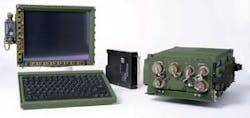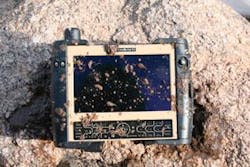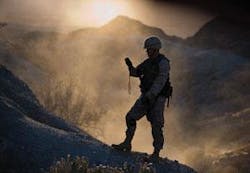Technology companies enable our military’s net-centric vision through smaller, faster, stronger computers.
By Courtney E. Howard
Computers are integral to the U.S. Department of Defense’s vision of a network-centric battlefield. They must be high-performance, economical, in many cases portable, and above all else, rugged. Rugged computing is essential to the goals that the military is trying to achieve on the battlefield.
“Warfare is changing, and information is now the key weapon,” says Tony Franklin, military, aerospace, and government segment manager at the Intel Corp. Embedded and Communications Group in Chandler, Ariz. “Everything over IP (Internet Protocol) is the goal, to get the right information to the right person at the right time, so they can make the right decisions.”
COTS in command
“The U.S. Department of Defense (DOD), the military, and specifically the U.S. Army are starting to use soldier-centric systems,” explains Franklin. “In the past, the Air Force would have had far more advanced electronic equipment than the foot soldier on the ground; that’s not the case anymore, and it’s going to be even less so the case moving forward.”
A typical soldier on the battlefield, if fully loaded, carries upwards of 120 pounds of gear. Given the weight of this load, the soldier cannot accommodate three different computers with three different security systems—such as a tablet computer, ruggedized laptop, and a manpack strapped to his back—and try to survive at the same time, Franklin acknowledges. “They need powerful compute platforms that will allow them to be on the move and on the go—that sounds a lot like what commercial customers want, and what mobile Internet devices are having to achieve to meet the needs of consumers today.” It is little wonder, then, that military organizations and defense firms are leveraging commercial off-the-shelf (COTS) technologies to meet soldier-centric and network-centric objectives.
“Many of the objectives that the Army, the DOD, and others have are really the same type of objectives and workloads of the commercial world—just usually in different packages, and more secure and ruggedized,” Franklin continues. “In the commercial world, people need plug-and-play; in the military environment, it’s plug-and-fight. On the commercial side, it’s performance per watt; in military terms, it’s performance per SWAP (size, weight, and power).”
DRS Tactical Systems has delivered Appliqué computer systems with multicore processors to the U.S. Army’s Force-21 Battle Command, Brigade and Below/Blue Force Tracking programs.
DOD officials want to use as much commercial technology as possible, but in many cases, they just cannot, continues Franklin. As a result, Intel and other technology companies partner to extend commercial technologies to meet the needs of the DOD. “Roper Mobile of Tempe, Ariz., is a perfect example of a firm taking products that we have developed for many of the same usage models in the commercial world—handhelds, mobile internet devices, etc.—and translating those to a military environment.”
Roper Mobile and other companies accomplish this product transformation via ruggedization of the computing system as a whole and its individual components. If not ruggedized, computing systems that are relied upon for mission-critical applications often fail; and some systems just can’t fail. They have to be counted upon to work all the time. They must be capable, cost-effective systems that soldiers can trust to work effectively when they are in harm’s way.
“The military’s digitization and net-centric efforts have driven requirements for rugged computer and display systems on the battlefield,” says Bill Guyan, vice president of business development for DRS Tactical Systems in Melbourne, Fla. “Battlefield environmental extremes like desert temperatures, dust, shock, humidity, and vibration will cause failures in commercial computers–even the toughest of commercial or ruggedized systems. There are times when a re-boot, system repair, or system replacement are unacceptable.”
Mobile medical units
The U.S. Army’s Medical Research and Material Command at Fort Detrick in Frederick, Md., manages data and information technology (IT) requirements, biomedical research and development, medical material management, and global telecommunications. It also oversees the construction of medical facilities for the Army’s Medical Department (AMEDD), which is focused on providing mobile medical care to soldiers. One program developed at Fort Detrick is Medical Communications for Combat Casualty Care (MC4), which supports a medical information management system for Army tactical medical forces that enhances medical situational awareness for operational commanders.
The MC4 system employs rugged mobile computers from Panasonic Computer Solutions Co. in Secaucus, N.J., as well as networking and peripheral equipment to receive, store, process, transmit, archive, and report medical information to command and control. The system must be portable, durable, and reliable to support field medics deployed in harsh environmental conditions and to ensure soldiers get the necessary care on the battlefield.
The Military Rugged Tablet (MRT) from DRS Tactical Systems has been adopted by the Air Force Tactical Air Control Party Program and the Marine Corps Target Location Designation Handoff System/Strikelink Program.
U.S. Army officials selected Panasonic Toughbook mobile PCs as their field medic tool for the MC4 program, which has an install base of 12,000 units, based on model past performance, testing, and technical specifications, and references from other Army divisions that have Toughbook notebooks in service. The field medics’ Toughbooks deliver warranty and spares kit services, video graphics, expanded memory, and an integrated common access card (CAC) reader for security. Currently, more than 100,000 Toughbooks are deployed in Iraq and Afghanistan, says Dante Conrad, executive area sales manager, Panasonic Computer Solutions Company–Army Division.
“Rugged notebooks are essential for military users, who need the technology to perform every day in any condition,” Conrad mentions. “There is no question that military users will continue to use and value rugged notebook computers.”
Panasonic Toughbooks are custom designed and engineered from the inside out to be reliable in the extreme conditions of military users, he says. The rugged Toughbook 19 and Toughbook 30 are MIL-STD-810F-tested for in-vehicle vibration, sand, rain, moisture, temperature extremes, and drops and shocks.
IT connectivity
Product life cycles are a major concern to military customers, not only because of the economic costs of replacing systems, but also because warfighters and other personnel are left without secure and reliable IT resources. Panasonic’s rugged Toughbooks have an average failure rate of less than 2 percent, exceeding the estimated industry average (ranging from 15 percent to more than 20 percent per year). Jan OHara, senior director, Panasonic Computer Solutions Company’s federal division, attributes the Toughbook’s reliability to the company’s “approach to designing, manufacturing, testing, and supporting computers that are built tough, from the inside out.”
Decision makers in the U.S. Navy must agree, given that they chose to equip military users with Panasonic rugged notebook computers as part of Electronic Data Systems (EDS) management of the Navy Marine Corps Intranet (NMCI). The IT backbone of the Department of the Navy (DoN), NMCI enterprise-wide intranet provides roughly 72,000 users, including warfighters, a range of network-based information services via rugged computers.
Roper Mobile Technology debuted the first rugged ultra-mobile personal computer (UMPC), the SwitchBack PC.
The Panasonic Toughbooks provided under this contract are designed to be reliable in mission-critical environments, and are ruggedized with magnesium alloy cases and shock-mounted, removable hard drives. Certified to MIL-STD-810F and tested to withstand drops, shocks, vibration, and temperature extremes, these Toughbooks come equipped with a cable lock slot, the Trusted Platform Module (TPM v1.2) security chip, BIOS-level support for Absolute’s Computrace anti-theft application, and optional fingerprint scanners to ensure security.
Tablet PCs
Security and ruggedness were high priorities for the U.S. Army Force-21 Battle Command Brigade and Below (FBCB2)/Blue Force Tracking (BFT) Programs. Army officials gained the help of engineers at DRS Tactical Systems, a division of DRS Technologies of Parsippany, N.J., who supplied custom-designed, ultra-rugged computing systems using commercial off-the-shelf (COTS) components.
To date, these DRS Tactical Systems rugged computer and display systems—specifically, models V4, EV4, and JV5—are deployed throughout the U.S. Army and U.S. Marine Corps (U.S.M.C.) to provide situational awareness and platform battle command capabilities. More than 40,000 of these systems have been delivered, with more than 25,000 additional systems on order, says DRS Tactical Systems’ Guyan. Moreover, he continues, the company has provided more than 13,000 rugged systems—including the rugged notebook (BMDT), rugged tablet (VUDT), and rugged two-piece computing and display system (PBPU and CCS)—to General Dynamics U.K. for the United Kingdom Bowman program.
DRS Tactical Systems engineers are also producing the Military Rugged Tablet (MRT) for the U.S. Air Force Tactical Air Control Party (TACP-M) Program for close air support (CAS) coordination, as well as for the U.S.M.C. Target Location Designation Handoff System (TLDHS)/Strikelink Program to provide Marines the ability to call for air, ground, and naval gunfire support.
Military personnel on the battlefield are equipped with advanced electronic equipment, such as handheld computers that incorporate the latest commercial technologies, such as Intel processors.
This month, DRS Tactical Systems engineers also began delivering, as part of a $5 million award from Stauder Technologies in St. Peters, Mo., hundreds of its military rugged tablet (MRT) computers and peripheral equipment to the U.S. Marine Corps’ TLDHS program.
The DRS MRT is a lightweight, ultra-rugged mobile computing device designed to serve as the man-machine interface for the TLDHS program. Designed to military standards and resistant to extreme environments, the MRT features a removable, rotating hard drive, milled aluminum housing, a 10.4-inch display in pen or touch-screen format, and a selective availability anti-spoofing module (SAASM) global positioning system (GPS).
DRS Tactical Systems products are built rugged and engineers select the LCD, processor, power supply, connectors, hard drive, and material in the enclosure to ensure its reliability under extreme conditions.
Small form factor
“The ability to have a computer that is able to withstand extreme battlefield environments as well as provide network connectivity, situational awareness, and outdoor viewability is critical for today’s forces,” admits Mike DiBiase, General Dynamics Computing Technologies Division vice president and general manager. “It is key that these options are available in forms that are easily accessible to the user. One of our latest products, the GoBook MR-1, is a small-form-factor computer that provides all these capabilities, while being small enough to fit into a soldier’s BDU (battle dress uniform) pocket.”
General Dynamics C4 Systems has received a $75 million order on the Common Hardware/Software 3 (CHS-3) contract from the U.S. Army for military hardware and software, including computers and network equipment for the Warfighter Information Network–Tactical (WIN-T) Program.
“Incorporating situational awareness applications, multiple network connectivity, and an outdoor viewable display in an environmentally rugged solution meets many customer needs,” says DiBiase. “Many customers are looking for a highly mobile solution.”
Rugged PDAs
Handheld computers are not only the choice of military personnel in the U.S. Marine Corps TLDHS program and the U.S. Army’s FBCB2 program, but throughout the services and their ranks.
“Soldiers need to be able to move quickly, leaving the vehicle, and taking their connection to the ’net with them, as well as their individual situational awareness,” says Jim English, vice president of business development and marketing at Tallahassee Technologies (Talla-Tech) Inc. in Tallahassee, Fla. “In today’s transformational forces, situational awareness is only a baseline of a warfighter’s needs. Equally important is his ability to connect to the network and perform as a sensor so that his capabilities in a given location can be leveraged. The enabling technology for this need is the rugged handheld computer. We have found that while the physical size and weight of the device is important, it cannot be traded for less durability, capability, or expandability.”
Engineers at BAE Systems in Rockville, Md., also saw value in the use of a portable, rugged computing platform, selecting Talla-Tech’s personal digital assistant (PDA) as the digital controller for the Joint Tactical Radio System (JTRS) Ground Mobile Radio (GMR) system.
Warfighters in the field rely on mobile computers, such as rugged laptops, for situational awareness, communications, and more.
“Considered a pivotal DOD transformation program, the JTRS is a defense department-wide initiative to develop a family of revolutionary software-programmable tactical radios that will provide the warfighter with voice, data, and video communications, as well as interoperability across the joint battlespace,” according to a DOD representative.
“Working with BAE and Boeing, we have developed a Rugged PDA (RPDA) that will host the controller capability for the JTRS radio in a customized back,” says Jim English, vice president of business development and marketing at Talla-Tech.
The Talla-Tech RPDA-57 will serve as the primary interface, referred to as the Personal Control Display Device (PCDD), of the GMR system, the first in a series of JTRS radio procurements for the joint services. The RPDA-57 multifunction military Rugged PDA computer, designed to deliver real-time data in harsh combat environments, is the fifth generation of the Talla-Tech Windows Mobile Rugged PDA, the first military-rugged PDA in production. It was designed with the rigors of the battlefield in mind, with features derived from front-line user input, English says.
The RPDA uses COTS components, explains English, “but they are often ordered in custom configurations, specifically suited for unique missions, such as ballistics, blue-force tracking, vehicular situational awareness, vehicle or platform diagnostics, medical prognosis, or the live monitoring of a remote radar device. The field-configurable design of our systems allows a user to change the back of the RPDA to add a SAASM GPS, an Iridium satellite connection, a Taclink connection, an extended battery, or several other options.”
The RPDA-57 sports an Intel 520 MHz PXA-270 processor running on a 400 MHz front-side bus, 128 megabytes of RAM, and 128 megabytes of ROM. The RPDA-57’s modular design breeds flexibility, enabling the RPDA to be offered in wireless or non-wireless configurations, with a Windows CE 5.0 or Windows Mobile 6.0 operating system, and with such options as PCMCIA card slots, tactical modem protocols, a military global positioning system, and support for multiple mission profiles.
“According to accounts from the field, they have been reported to survive IED attacks and continue functioning as they were prior to the explosion,” English reports. “These computers were the only surviving technologies in the vehicles. Had they been less rugged, the warfighters could not have depended on them for navigation home.”
Viable vetronics
Computers in combat vehicles need to be as rugged and compact as soldier-worn systems, if not more so. After all, they must withstand the same environmental conditions as foot soldiers, as well as greater shock and vibration, dust and debris, and limited space.
Product developers at Mercury Computer Systems Inc. in Chelmsford, Mass., are well aware of these factors. The company’s battlefield-deployed rugged products are at work in airborne, ship-borne, and ground-based platforms—intelligence, surveillance, and reconnaissance (ISR) applications such as radar, electro-optics/infrared (EO/IR), and signals intelligence; ship-borne radar, sonar processing, and signals intelligence applications; and radars and imaging systems on the ground.
“The ruggedness of these environments ranges from less challenging to more severe,” admits Arlan Pool, fellow and technical director, defense business development, Mercury Computer Systems. “The less-extreme environments require products that are ruggedized for extended temperature, humidity, and vibration. The more-severe environments, such as systems in pods on fighter aircraft making aircraft carrier landings, require conduction cooling and increased capability for shock and vibration.”
Mercury’s PowerStream 6600 is a rugged conduction-cooled system designed to meet the requirements of challenging environments, such as processing in mobile ground vehicles. The 6U system is compliant to the VPX-REDI (VITA 46 and VITA 48) specifications, uses a serial RapidIO fabric, can be configured with both PowerPC and Xilinx FPGA processors, and uses XMC (VITA 42) modules for I/O.
“Rugged computing is about achieving an application’s system level of processing and I/O, while meeting the constraints of size, weight, and power (SWAP) and environmental specifications,” Pool notes. Mercury’s military customers are continually seeking increased processing performance with lower power consumption. “The challenge is integrating today’s processors, which along with higher performance have higher power, and thus higher temperature, into dense rugged systems. The thermal management of these higher-powered processors requires some innovation.” Mercury’s patented Finely Managed Air technique handles thermal management in the PowerStream 7000 product family, whereas power consumption is addressed with processors that deliver the best possible performance per watt, such as PowerPC processors from P.A. Sem.
Pool anticipates the trend toward smaller systems with increased processing power and storage to continue in battlefield environments. “This technology trend will allow more processing to be performed in real time, resulting in decreased latency, increased functionality, and enhanced communication and networking. These small rugged systems, particularly in the network-centric model, will enable new applications providing better information, such as sensor fusion, for the warfighter.”
Multicore mastery
“There have been two really exciting developments in the military computing business,” notes DRS Tactical Systems’ Guyan. “First is the acceptance and adoption of the tablet form-factor by an increasing number of military customers.” In fact, the company’s 10-inch Military Rugged Tablet (MRT) has been adopted for use in mission-critical applications by customers in the U.S. Air Force, U.S. Army, and U.S. Marine Corps.
“The second and more important development,” Guyan continues, “has been the evolution of multicore COTS processing technology, which promises to revolutionize the way computing is done in the military. Instead of large and expensive computer housings stuffed full of individual ruggedized computer boards for each application, multicore computing allows for multiple applications, and even operating systems, to be running on a single CPU board.”
DRS Technologies’ DRS Tactical Systems unit delivered Appliqué computer systems with multicore processors to the U.S. Army’s FBCB2 Blue Force Tracking programs. The work stems from a $131 million contract award from the U.S. Army’s Communications-Electronics Life Cycle Management Command (CELCMC) at Fort Monmouth, N.J.
The Appliqué computer systems’ multicore processors, increased memory, and expansion capability enable improved graphics processing, data handling, and system networking. The computer systems meet the Army’s BFT requirements and are being installed on more than 40 types of U.S. Army and Marine Corps wheeled and tracked vehicles, at tactical operations centers and other command-post platforms.
“This contract award is the largest order we’ve received from the U.S. Army to provide or upgrade our rugged tactical computers for their FBCB2/BFT programs,” says Michael J. Sheehan, president of DRS Technologies’ Tactical Computing strategic business unit. “Our Appliqué computer system has proven its value and reliability during demanding combat operations.”
The goal of the FBCB2/BFT programs is to deliver a digital battle command-and-control information system that will provide commanders and soldiers at tactical units, from the brigade level to the individual soldier, with access to real-time information, thereby enabling improved decision making, enhanced situational awareness, and a battlefield advantage.
The FBCB2/BFT computer systems harness DRS technology to provide tactical units with GPS data and the abilities to track and decipher friends and foes via a combat identification system, to interface with terrestrial communication radios, and to access a satellite communications system.
“The technology shift to multicore processor architectures—such as seen with Intel, AMD, the PowerPC, and the Cell BE—will bring significant increases in performance density for small rugged systems,” Mercury’s Pool says. “Performance density is how much computational performance can be integrated into a given size, weight, and power (SWAP) footprint.”
Servers in severe conditions
“Battlefield computing is all about severely constrained environments, where there is a high premium on SWAP and where thermal and kinetic management can make the marginal difference between survivability and failure, in combat,” says William E. Kehret, president and CEO, Themis in Fremont, Calif.
Themis engineers have focused on the server side of these applications, concentrating on modular maintainability and SWAP efficiency, and are at work on next-generation server architectures and infrastructure software to support the networked battlefield of the future.
“One of the most recent architectural trends to address efficient battlefield computing is the hosting of server oriented architecture (SOA) applications, on virtualized servers,” Kehret continues.
U.S. Marine Corps officials reportedly plan to take server virtualization software into war in an effort to improve the way IT is deployed on the battlefield. The U.S. Marine Corps, which operates roughly 12,000 x86-based servers, is adopting an enterprise-wide approach to virtualization. In partnership with VMware Inc. of Palo Alto, Calif., the U.S.M.C. plans to reduce its current total of roughly 300 data centers to just 30 facilities and 100 mobile platforms.
“The virtualization of applications off dedicated computers, using service oriented architectures, the hosting of those applications on virtualized machines running on multicore, multithreaded server platforms, all interconnected by high-performance networks, with distributed security and user authentication, are the wave of the future, not just in military computing but in all mission critical computing, commercial and military alike,” Kehret says.
High performance, small size
“Our products allow the DOD and first responders to move true computing capability closer to the end users without forcing them to accept lower-performing mobile processors or lower-capacity storage devices,” says Scott Kongable, president of Crystal Group Inc. in Hiawatha, Iowa.
Crystal Group offers rugged servers, displays, and storage systems using commercially available electronics. Kongable and his team at Crystal Group are receiving increased requests for large amounts of storage, with attached processing, in a rugged enclosure.
“We have designed the rugged chassis and techniques to allow the use of commercially available motherboards, processors, memory, and storage in high-temperature, high-vibration, and high mechanical shock environments,” says Kongable. “Our servers are manufactured from milled aircraft aluminum, which reduces the flexing that electronics experience during vibration and shock, and provides improved heat dissipation. We also ruggedize the commercial motherboards, power supplies, etc., used in our servers. It allows the user to stay on the leading edge of computing capability without sacrificing the environmental performance they need.”
The speed at which products that meet specific environmental or form factor requirements can be designed and fielded is another important consideration for military users, acknowledges Kongable. “Users know they need to use commercial technology for cost and performance reasons, but they also have specific demands with respect to environmental, form factor, I/O, and so on,” he explains. “Our approach in dealing with the needs of the user community is to bring all our design and manufacturing in-house, providing quick, cost-effective response to those needs.”
One example involved the development and shipment of a 4U server/NAS (network attached storage, model RS47F) approximately five weeks from initial contact with the customer. Moreover, Crystal Group’s new RS232-S13 and RS232-S17 servers, based on the company’s standard 2U RS235, have been adopted for steering and navigation subsystems in the DDG Modernization Program. The RS series servers’ modular design enabled Crystal Group engineers to create custom designs to meet the customer’s mechanical requirements for shorter, rugged systems to fit into the available space.
Crystal Group’s Kongable is enthusiastic about the future of rugged computing platforms on the digital battlefield, as are various executives at industry-leading technology firms. For example, Crystal Group’s focus on providing the latest computational and storage capability in the smallest and lightest form factors possible is anticipated to extend to wearable computers and displays, among other innovations. “There is increasing demand for sealed and immersible servers that provide the greatest computational capability in high sand/dust, high-temperature environments,” says Kongable.









